
Keiji Inafune.
Keiji Inafune (稲船 敬二, Inafune Keiji?, born May 8, 1965) was the head of Research & Development and Online Business at Capcom, best known for being the character designer of Mega Man and producer of Onimusha: Warlords and Dead Rising. In most game credits, he uses the name "INAFKING". Characters from the Street Fighter and Mega Man series have become some of the most well-known and recognizable game characters, making Keiji Inafune a large part of Capcom's success.
In October 2010, Inafune resigned after a 23 year tenure, claiming he was dissatisfied with the future of Japanese game development. He currently works at Inti Creates.
History[]
In 1987, 22-year old Keiji joined the corporation of Capcom not long after graduating in search of a job as an illustrator. His first assignment as graphic designer was Street Fighter, which became a very popular fighting game series after the release of Street Fighter II in 1992. At the time, Capcom focused on the expansion of the home video gaming market; particularly the Famicom from Nintendo. Previously, most games released to the system were ports. Now wanting to capitalize on the fledgling Nintendo system, Keiji's superiors directed him to continue on a new video game called "Rockman." Capcom's artist and developer teams were still diminutive at that period in time, and so Keiji was to be one of the artists on the new project.

When it came to the design for the Rockman game (which was later changed to Mega Man in North America), Keiji, with other artists, developed all the character art and designs. Due to the small taskforce, he also constructed the characters into pixel form, as well as the game's respective logo, package design, and instruction booklet. As the Famicom was an early gaming system, only 56 colors were available for display, the majority of which were blue-tinted. This affected his decision to color the character blue (as a result, fans have nicknamed the character "the blue bomber"). The designs of Keiji's character were also heavily influenced by Japanese animation, and he notes that he took observations from other fictional characters present at the time, such as Mario and Astro Boy.

Cartoon drawing of Keiji.
In development of the game, Keiji incorporated many references to various music genres, such as Rock, which is the source of the Japanese name of "Rockman." Along with this, the team made a gaming system pertaining to the rock-paper-scissors concept, one which the various Mega Man series still revolves around today. The first Rockman/Mega Man game was released in December 1987, after which sales in both countries were competent, but as Keiji later notes; "While it did sell more than we had expected, [Rockman 1] wasn't a huge success as far as the numbers go." Noting this, Capcom superiors dictated that the team begin on a new project called Professional Baseball Murder Mystery, which was only released in Japan.
However, the team felt strongly about the Rockman series, and urged that they be permitted to construct another iteration in order to amend the previous failings of the original and continue in the light of creativity. Capcom allowed the Rockman team to continue, with the prerequisites of completing Professional Baseball Murder Mystery as well. The team did so, completing the project on their own time, and on December 24, 1988, released Rockman 2, with Mega Man 2 being released later in North America in 1989. The project proved to be a huge success, earning more than its previous iteration. Mega Man 2 is Inafune's favorite Mega Man game. Coincidentally, fans widely consider it to be the best Mega Man game, because of its production values, such as graphics, music, etc. Capcom realized that the Mega Man series was a profitable investment, and many ports were constructed along with regular installments released on a yearly basis.
Works[]
Capcom[]

Concept artwork of Ryu, Nina, Ox, and Mogu from the original "Breath of Fire".
- Mega Man -- Character Design
- Mega Man 2 -- Character Design
- Mega Man 3 -- Sub-Planner, Character Design
- Mega Man 4 -- Planner, Character Design
- Breath of Fire -- Original illustrator
- Mega Man 8 -- Producer
- Mega Man & Bass -- Producer
- Mega Man Soccer -- Illustrator
- Mega Man Battle & Chase -- Producer
- Mega Man 9 -- Producer, Character Designer
- Mega Man X -- Planner, Character Design, Illustrator
- Mega Man X2 -- Character Design, Illustrator
- Mega Man X3 -- Character Design, Illustrator
- Mega Man X4 -- Producer
- Mega Man Zero -- Producer
- Mega Man Legends -- Producer
- The Misadventures of Tron Bonne -- Producer
- Mega Man Legends 2 -- Producer
- Mega Man Battle Network -- Producer
- Mega Man ZX -- Producer
- Mega Man Star Force -- Producer
- Onimusha: Warlords -- Producer
- Onimusha 2: Samurai's Destiny -- Producer
- Onimusha Blade Warriors –- Executive producer
- Onimusha 3: Demon Siege –- Executive producer
- Onimusha: Dawn of Dreams –- Executive producer
- Shadow of Rome -- Executive producer
- Street Fighter IV - Executive producer
- Dead Rising -- Producer
- Dead Rising 2 -- Producer
